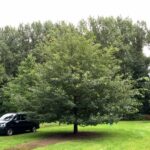Pterocarya fraxinifolia - Caucasian Wingnut
The wing nut often grows in multiple stems to form large trees with a picturesque crown. The branches grow in curved arches and can reach heights of around 25 m. The overall impression is upright, closed and picturesque. The overall impression is upright, closed and picturesque.
New shoots often grow from the extensive root system. Almost jungle-like thickets can develop.
The bark is matt grey, black-grey when old and has conspicuous light longitudinal furrows. The twigs are airy and fanned out on the inside.
The winter buds are inconspicuous, only the tips of the shoots have fan-like to comb-like folded leaves.
The wing nut is deciduous. The leaves are alternate on the twig, they are pinnate and up to 60 cm long. They are dark green on top and lighter coloured underneath.
The autumn colours come in many bright yellow shades.
The fruits are special. The wing nut is monoecious. The thick male catkins appear with the leaves at the end of April to May, at the same time the female flowers appear as if threaded on spindles about 40 cm long. The fruits then have a ring-shaped wing up to 2 cm wide in summer. This is where the name ‘wing nut’ comes from.
Pterocarya fraxinifolia grows in nutrient-rich, well-drained soil. It can be acidic but also alkaline, wet or dry. Long floods are well tolerated. The roots grow shallow, wide but also deep. The site can be sunny or shady. The wingnut is therefore very adaptable to its environment.
The wing nut is well frost-hardy WHZ 5a.
The early shoots can cause frost damage, but this is quickly overgrown.
Pterocarya fraxinifolia is resistant to urban climates and wind. Old trees yield very good and valuable veneer wood.
The wingnut combines many positive characteristics, making it a tree for the future.






